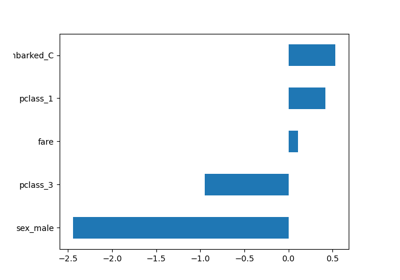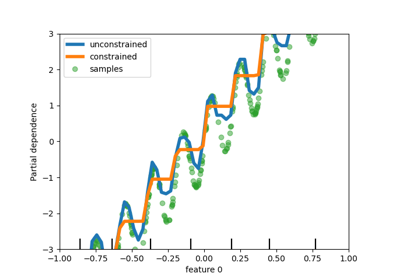注意
转到末尾以下载完整示例代码或通过 JupyterLite 或 Binder 在浏览器中运行此示例。
显示管道#
在 Jupyter Notebook 中显示管道的默认配置是 'diagram',其中 set_config(display='diagram')。要禁用 HTML 表示,请使用 set_config(display='text')。
要查看管道可视化的更多详细步骤,请单击管道中的步骤。
# Authors: The scikit-learn developers
# SPDX-License-Identifier: BSD-3-Clause
显示包含预处理步骤和分类器的管道#
本节构建一个包含预处理步骤 StandardScaler 和分类器 LogisticRegression 的 Pipeline,并显示其可视化表示。
from sklearn import set_config
from sklearn.linear_model import LogisticRegression
from sklearn.pipeline import Pipeline
from sklearn.preprocessing import StandardScaler
steps = [
("preprocessing", StandardScaler()),
("classifier", LogisticRegression()),
]
pipe = Pipeline(steps)
要可视化图表,默认设置为 display='diagram'。
set_config(display="diagram")
pipe # click on the diagram below to see the details of each step
Pipeline(steps=[('preprocessing', StandardScaler()),
('classifier', LogisticRegression())])在 Jupyter 环境中,请重新运行此单元格以显示 HTML 表示形式或信任 notebook。在 GitHub 上,HTML 表示形式无法渲染,请尝试使用 nbviewer.org 加载此页面。
参数
参数
参数
要查看文本管道,请更改为 display='text'。
set_config(display="text")
pipe
Pipeline(steps=[('preprocessing', StandardScaler()),
('classifier', LogisticRegression())])
恢复默认显示
set_config(display="diagram")
显示链接多个预处理步骤和分类器的管道#
本节构建一个包含多个预处理步骤(PolynomialFeatures 和 StandardScaler)和一个分类器步骤(LogisticRegression)的 Pipeline,并显示其可视化表示。
from sklearn.linear_model import LogisticRegression
from sklearn.pipeline import Pipeline
from sklearn.preprocessing import PolynomialFeatures, StandardScaler
steps = [
("standard_scaler", StandardScaler()),
("polynomial", PolynomialFeatures(degree=3)),
("classifier", LogisticRegression(C=2.0)),
]
pipe = Pipeline(steps)
pipe # click on the diagram below to see the details of each step
Pipeline(steps=[('standard_scaler', StandardScaler()),
('polynomial', PolynomialFeatures(degree=3)),
('classifier', LogisticRegression(C=2.0))])在 Jupyter 环境中,请重新运行此单元格以显示 HTML 表示形式或信任 notebook。在 GitHub 上,HTML 表示形式无法渲染,请尝试使用 nbviewer.org 加载此页面。
参数
参数
参数
参数
显示管道、降维和分类器#
本节构建一个包含降维步骤 PCA 和分类器 SVC 的 Pipeline,并显示其可视化表示。
Pipeline(steps=[('reduce_dim', PCA(n_components=4)),
('classifier', SVC(kernel='linear'))])在 Jupyter 环境中,请重新运行此单元格以显示 HTML 表示形式或信任 notebook。在 GitHub 上,HTML 表示形式无法渲染,请尝试使用 nbviewer.org 加载此页面。
参数
参数
参数
显示链接 Column Transformer 的复杂管道#
本节构建一个包含 ColumnTransformer 和分类器 LogisticRegression 的复杂 Pipeline,并显示其可视化表示。
import numpy as np
from sklearn.compose import ColumnTransformer
from sklearn.impute import SimpleImputer
from sklearn.linear_model import LogisticRegression
from sklearn.pipeline import Pipeline, make_pipeline
from sklearn.preprocessing import OneHotEncoder, StandardScaler
numeric_preprocessor = Pipeline(
steps=[
("imputation_mean", SimpleImputer(missing_values=np.nan, strategy="mean")),
("scaler", StandardScaler()),
]
)
categorical_preprocessor = Pipeline(
steps=[
(
"imputation_constant",
SimpleImputer(fill_value="missing", strategy="constant"),
),
("onehot", OneHotEncoder(handle_unknown="ignore")),
]
)
preprocessor = ColumnTransformer(
[
("categorical", categorical_preprocessor, ["state", "gender"]),
("numerical", numeric_preprocessor, ["age", "weight"]),
]
)
pipe = make_pipeline(preprocessor, LogisticRegression(max_iter=500))
pipe # click on the diagram below to see the details of each step
Pipeline(steps=[('columntransformer',
ColumnTransformer(transformers=[('categorical',
Pipeline(steps=[('imputation_constant',
SimpleImputer(fill_value='missing',
strategy='constant')),
('onehot',
OneHotEncoder(handle_unknown='ignore'))]),
['state', 'gender']),
('numerical',
Pipeline(steps=[('imputation_mean',
SimpleImputer()),
('scaler',
StandardScaler())]),
['age', 'weight'])])),
('logisticregression', LogisticRegression(max_iter=500))])在 Jupyter 环境中,请重新运行此单元格以显示 HTML 表示形式或信任 notebook。在 GitHub 上,HTML 表示形式无法渲染,请尝试使用 nbviewer.org 加载此页面。
参数
参数
['state', 'gender']
参数
参数
['age', 'weight']
参数
参数
参数
显示包含分类器的管道上的网格搜索#
本节构建一个包含 RandomForestClassifier 的 Pipeline 上的 GridSearchCV,并显示其可视化表示。
import numpy as np
from sklearn.compose import ColumnTransformer
from sklearn.ensemble import RandomForestClassifier
from sklearn.impute import SimpleImputer
from sklearn.model_selection import GridSearchCV
from sklearn.pipeline import Pipeline, make_pipeline
from sklearn.preprocessing import OneHotEncoder, StandardScaler
numeric_preprocessor = Pipeline(
steps=[
("imputation_mean", SimpleImputer(missing_values=np.nan, strategy="mean")),
("scaler", StandardScaler()),
]
)
categorical_preprocessor = Pipeline(
steps=[
(
"imputation_constant",
SimpleImputer(fill_value="missing", strategy="constant"),
),
("onehot", OneHotEncoder(handle_unknown="ignore")),
]
)
preprocessor = ColumnTransformer(
[
("categorical", categorical_preprocessor, ["state", "gender"]),
("numerical", numeric_preprocessor, ["age", "weight"]),
]
)
pipe = Pipeline(
steps=[("preprocessor", preprocessor), ("classifier", RandomForestClassifier())]
)
param_grid = {
"classifier__n_estimators": [200, 500],
"classifier__max_features": ["auto", "sqrt", "log2"],
"classifier__max_depth": [4, 5, 6, 7, 8],
"classifier__criterion": ["gini", "entropy"],
}
grid_search = GridSearchCV(pipe, param_grid=param_grid, n_jobs=1)
grid_search # click on the diagram below to see the details of each step
GridSearchCV(estimator=Pipeline(steps=[('preprocessor',
ColumnTransformer(transformers=[('categorical',
Pipeline(steps=[('imputation_constant',
SimpleImputer(fill_value='missing',
strategy='constant')),
('onehot',
OneHotEncoder(handle_unknown='ignore'))]),
['state',
'gender']),
('numerical',
Pipeline(steps=[('imputation_mean',
SimpleImputer()),
('scaler',
StandardScaler())]),
['age',
'weight'])])),
('classifier',
RandomForestClassifier())]),
n_jobs=1,
param_grid={'classifier__criterion': ['gini', 'entropy'],
'classifier__max_depth': [4, 5, 6, 7, 8],
'classifier__max_features': ['auto', 'sqrt', 'log2'],
'classifier__n_estimators': [200, 500]})在 Jupyter 环境中,请重新运行此单元格以显示 HTML 表示形式或信任 notebook。在 GitHub 上,HTML 表示形式无法渲染,请尝试使用 nbviewer.org 加载此页面。
参数
参数
['state', 'gender']
参数
参数
['age', 'weight']
参数
参数
参数
脚本总运行时间: (0 minutes 0.134 seconds)
相关示例



